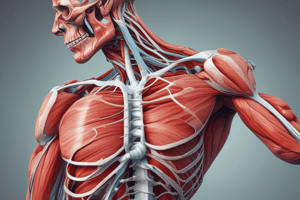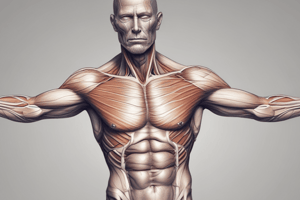Podcast
Questions and Answers
Which type of muscle tissue is primarily responsible for controlling movements?
Which type of muscle tissue is primarily responsible for controlling movements?
- Hartspier
- Smooth muscle
- Skeletal muscle (correct)
- Cardiac muscle
What is the main function of smooth muscle?
What is the main function of smooth muscle?
- Control of movements
- Pumping blood
- Constriction of organs (correct)
- Transmission of electrical signals
Which type of muscle tissue is attached to bones through tendons?
Which type of muscle tissue is attached to bones through tendons?
- Cardiac muscle
- Smooth muscle
- Skeletal muscle (correct)
- Hartspier
What is the main function of cardiac muscle?
What is the main function of cardiac muscle?
In which type of muscle tissue is the primary function to constrict various structures such as hollow organs and vessels?
In which type of muscle tissue is the primary function to constrict various structures such as hollow organs and vessels?
Which type of muscle tissue is primarily responsible for controlling movements?
Which type of muscle tissue is primarily responsible for controlling movements?
What is the primary function of smooth muscle?
What is the primary function of smooth muscle?
In which type of muscle tissue is the action primarily to decrease the joint angle?
In which type of muscle tissue is the action primarily to decrease the joint angle?
Where is smooth muscle primarily located?
Where is smooth muscle primarily located?
Which type of muscle tissue is found in the walls of the heart and responsible for its contractions?
Which type of muscle tissue is found in the walls of the heart and responsible for its contractions?
Which type of muscle is primarily responsible for controlling movements in the human body?
Which type of muscle is primarily responsible for controlling movements in the human body?
What is the primary function of smooth muscle in the human body?
What is the primary function of smooth muscle in the human body?
Where is cardiac muscle primarily found in the human body?
Where is cardiac muscle primarily found in the human body?
What is the main function of skeletal muscle in the human body?
What is the main function of skeletal muscle in the human body?
Which type of muscle primarily performs the action of decreasing the joint angle in the human body?
Which type of muscle primarily performs the action of decreasing the joint angle in the human body?
Flashcards are hidden until you start studying
Study Notes
- Skeletal muscle makes up approximately 40% of human body weight
- Attached to bones through tendons and responsible for controlling movements
- Parts of skeletal muscles and their functions:
- Extensor: increases joint angle
- Flexor: decreases joint angle
- Abductor: moves away from the center line
- Adductor: moves towards the center line
- Levator: moves upwards
- Depressor: moves downwards
- Pronator: rotates forearm
- Supinator: rotates forearm away from the body
- Rotator: rotates a joint
- Sphincter: causes contraction to close an opening
- Smooth muscle is found in the walls of hollow organs, vessels, eyes, glands, uterus, and skin
- Primary function is not related to movements but to the functions of the organs they are in
- Cardiac muscle is a type of striated muscle that is specialized for the contraction of the heart
- Contraction mechanism in skeletal muscles includes:
- Action potential: an electrical signal that triggers muscle contraction
- Excitation: the process by which a muscle is prepared for contraction
- Force-length relationship: the amount of force produced by a muscle depends on its length, which is defined as the length of the muscle fibers when it is not producing force
- Energy metabolism in relation to muscle contraction:
- Creatine phosphate (PC) provides energy for the first few seconds of muscle contraction
- Glycogen is broken down into glucose to produce energy for muscle contraction
- ATP is the primary energy source for muscle contraction
- Anaerobic metabolism produces energy without the use of oxygen, but it also produces waste products that can make muscle acidic and impair its function
- Aerobic metabolism produces energy with the use of oxygen and produces less waste products, but it takes longer for the energy to be available for muscle contraction.
- Lesson on muscle contraction energy metabolism was held on 25th November.
Studying That Suits You
Use AI to generate personalized quizzes and flashcards to suit your learning preferences.



